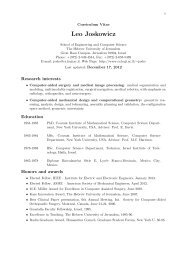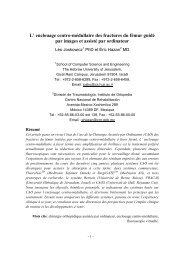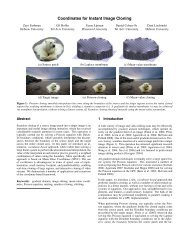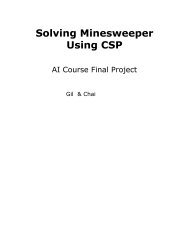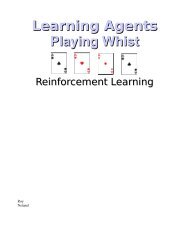TEL AVIV UNIVERSITY Gaddi Blumrosen
TEL AVIV UNIVERSITY Gaddi Blumrosen
TEL AVIV UNIVERSITY Gaddi Blumrosen
You also want an ePaper? Increase the reach of your titles
YUMPU automatically turns print PDFs into web optimized ePapers that Google loves.
and in the case of transmit diversity (single receive antenna):<br />
The new convex optimization problem is:<br />
Z arg min l(<br />
Z)<br />
(4.14)<br />
(4.15)<br />
1/<br />
2<br />
The optimal weight, W opt , is further obtained by square root of Z opt , W Z .<br />
Asymptotic properties of the solution<br />
1<br />
<br />
H 1 1 1 1<br />
h| hˆ hh| hˆ hh| hˆ hh| hˆ h| hˆ hh| hˆ<br />
l( Z) m R Z R R m logdet Z R<br />
opt<br />
0<br />
( ) 1 <br />
tr Z<br />
Z Z<br />
Z<br />
H<br />
Asymptotic properties of this solution, are special cases where a closed-form solution<br />
can be obtained, and enable understanding of the way OSTBC and BF are combined.<br />
4 cases are being examined:<br />
1. No channel knowledge (CSI).<br />
2. Perfect channel knowledge (CSI).<br />
3. Infinite SNR level.<br />
4. Close to zero SNR level.<br />
1<br />
In the first case, where no channel knowledge (CSI) is assumed, i.e., R hh/<br />
hˆ<br />
<br />
0,<br />
W becomes a scaled unitary matrix:<br />
W opt I Nt / NT<br />
(4.16)<br />
Thus, the codewords are transmitted without modification. This makes sense<br />
considering the assumptions under which the predetermined space–time code<br />
(OSTBC) was designed. It also makes sense in view of the fact that the transmitter<br />
does not know the channel and therefore has to choose a “neutral” solution.<br />
In the second case, perfect channel knowledge (CSI) is assumed, i.e., 0 . R<br />
As been shown in [25], since in OSTBC the decoding of the constituent data symbols<br />
decouples, the antenna weights should be parallel to the strongest left singular vector<br />
of the channel – beamforming in the direction of left singular vector of the channel<br />
(note that here channel estimates is the true channel) , defined as V . Thus we can<br />
assume that one of the eigen-values of is strictly larger than all the other. The solution<br />
of 4.13 becomes:<br />
Wopt [ VN<br />
, 00]<br />
T<br />
(4.17)<br />
Unlike SVD techniques, where the weights are in the direction of all eigenvectors,<br />
here the weights are in the direction of only the strongest eigenvectors (only one subchannel<br />
is used).<br />
2<br />
In the third case, Infinite SNR level is assumed, i.e. min <br />
<br />
Like in the first case, the optimal linear transformation can be chosen to be a scaled<br />
unitary matrix like (4.15). The usefulness of channel knowledge diminishes as the<br />
SNR increases due to optimal combining in the receiver and thus achieving maximum<br />
channel diversity gain.<br />
In the fourth case, low SNR level is assumed, i.e. , the solution<br />
of W also expressed by (4.16).<br />
4 / <br />
2<br />
<br />
min<br />
/ 4<br />
<br />
0<br />
opt<br />
NT<br />
hh/<br />
hˆ<br />
opt



